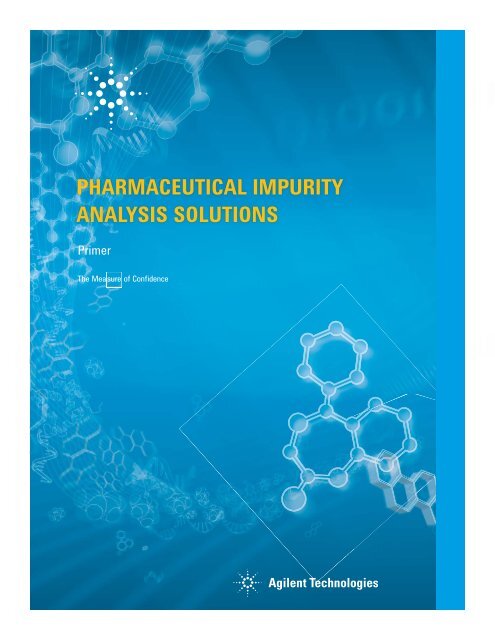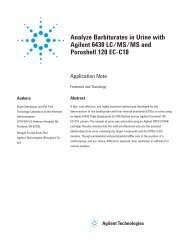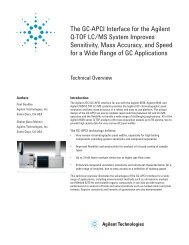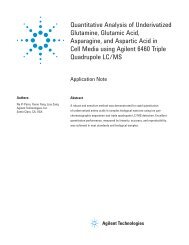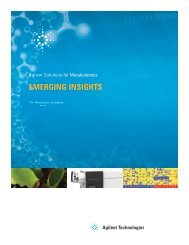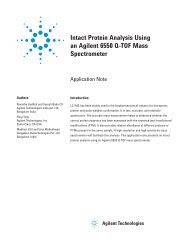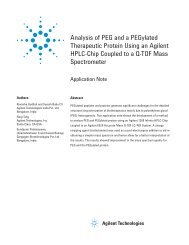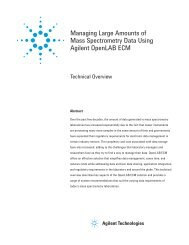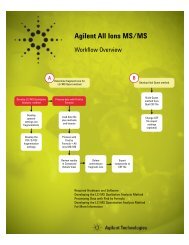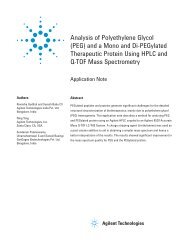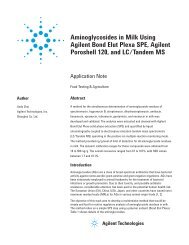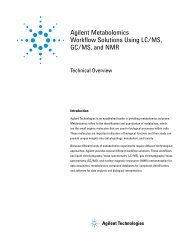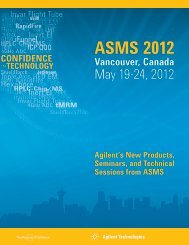pharmaceutical impurity analysis solutions - Lcms-connect.com
pharmaceutical impurity analysis solutions - Lcms-connect.com
pharmaceutical impurity analysis solutions - Lcms-connect.com
Create successful ePaper yourself
Turn your PDF publications into a flip-book with our unique Google optimized e-Paper software.
PHARMACEUTICAL IMPURITYANALYSIS SOLUTIONSPrimer
CONTENTS1. PHARMACEUTICAL IMPURITY ANALYSIS –OVERVIEW AND REGULATORY SITUATIONThe Three Major Categories of Pharmaceutical Impurities .....................................................................4Organic impurities .............................................................................................................................4Inorganic (elemental) impurities .......................................................................................................5Residual solvents ...............................................................................................................................5Selected Publications and Guidelines for the Control of Pharmaceutical Impurities ..............................72. ANALYTICAL TECHNOLOGIES FOR IMPURITY PROFILINGIN PHARMACEUTICAL DEVELOPMENTFourier Transform Infrared Spectroscopy (FTIR) .....................................................................................9Preparative Liquid Chromatography (LC) ................................................................................................9Liquid Chromatography and Ultraviolet Spectrometry (LC/UV)............................................................10Liquid Chromatography and Mass Spectrometry (LC/MS) ..................................................................11Capillary Electrophoresis (CE)................................................................................................................11Supercritical Fluid Chromatography (SFC)............................................................................................12Nuclear Magnetic Resonance Spectroscopy (NMR)............................................................................13Inductively-Coupled Plasma Optical Emission Spectroscopy (ICP-OES) and Inductively-CoupledPlasma Mass Spectrometry (ICP-MS)...................................................................................................13Gas Chromatography (GC) ....................................................................................................................143. A SELECTION OF AGILENT APPLICATION SOLUTIONSFOR THE THREE MAJOR TYPES OF IMPURITIESOverview ................................................................................................................................................153.1 ANALYSIS OF ORGANIC IMPURITIES ...............................................................................16Achieve precision, linearity, sensitivity, and speed in <strong>impurity</strong> <strong>analysis</strong> with the Agilent 1200Infi nity Series HPLC/UV Solutions ...................................................................................................16Improve profi ling productivity for the identifi cation of trace-level impurities using AgilentLC/Q-TOF <strong>solutions</strong> ..........................................................................................................................20Quantitative <strong>analysis</strong> of genotoxic impurities in APIs using Agilent LC/QQQ <strong>solutions</strong> ..................21Agilent Organic Impurity Profi ling Publications ...............................................................................233.2 ANALYSIS OF INORGANIC IMPURITIES ............................................................................24Determination of elemental impurities in <strong>pharmaceutical</strong> ingredients according to USPprocedures by Agilent ICP-OES and ICP-MS based <strong>solutions</strong> ........................................................24Agilent Elemental Impurity Analysis Publications ...........................................................................253.3 RESIDUAL SOLVENT ANALYSIS .........................................................................................26Faster <strong>analysis</strong> and enhanced sensitivity in residual solvent <strong>analysis</strong> as per USP procedures using Agilent GC based <strong>solutions</strong> .................................................................................26Agilent Residual Solvent Analysis Publications ...............................................................................28Appendix: Agilent Solutions for Pharmaceutical Impurity Analysis .......................................................293
1PHARMACEUTICAL IMPURITY ANALYSIS –OVERVIEW AND REGULATORY SITUATIONPharmaceuticals impurities are the unwanted chemicals that remain with active<strong>pharmaceutical</strong> ingredients (API) or drug product formulations. The impuritiesobserved in drug substances may arise during synthesis or may be derived fromsources such as starting materials, intermediates, reagents, solvents, catalysts, andreaction by-products. During drug product development, impurities may be formed asa result of the inherent instability of drug substances, may be due to in<strong>com</strong>patibilitywith added excipients, or may appear as the result of interactions with packagingmaterials. The amount of various impurities found in drug substances will determinethe ultimate safety of the fi nal <strong>pharmaceutical</strong> product. Therefore, the identifi cation,quantitation, qualifi cation, and control of impurities are now a critical part of thedrug development process.Various regulatory authorities focus on the control of impurities: the InternationalConference on Harmonization (ICH), the United States Food and Drug Administration(USFDA), the European Medicines Agency (EMA), the Canadian Drug and HealthAgency, the Japanese Pharmaceutical and Medical Devices Agency (PMDA), andthe Australian Department of Health and Ageing Therapeutic Goods. In addition, anumber of offi cial <strong>com</strong>pendia, such as the British Pharmacopoeia (BP), the UnitedStates Pharmacopeia (USP), the Japanese Pharmacopoeia (JP), and the EuropeanPharmacopoeia (EP) are incorporating limits that restrict the <strong>impurity</strong> levels present inAPIs as well as in drug formulations.The Three Major Categoriesof Pharmaceutical ImpuritiesAccording to ICH guidelines, impurities related to drug substances can be classifi ed intothree main categories: organic impurities, inorganic impurities, and residual solvents.1. Organic impuritiesOrganic impurities can arise in APIs or drug product formulations during themanufacturing process or during the storage of drug substances. They may beknown, unknown, volatile, or non-volatile <strong>com</strong>pounds with sources including startingmaterials, intermediates, unintended by-products, and degradation products. Theymay also arise from racemization, or contamination of one enantiomeric form withanother. In all cases they can result in undesired biological activity.Recently, genotoxic <strong>pharmaceutical</strong> impurities, which may potentially increasecancer risks in patients, have received considerable attention from regulatorybodies and <strong>pharmaceutical</strong> manufacturers. In general, genotoxic impurities includeDNA reactive substances that have the potential for direct DNA damage. Potentialgenotoxic impurities include process impurities or degradants, present at tracelevels, which are generated during drug manufacturing and storage. As per FDA andEMA guidelines, potential genotoxic impurities are to be controlled at levels muchlower than typical impurities. The re<strong>com</strong>mended acceptable thresholds for genotoxicimpurities in <strong>pharmaceutical</strong>s can be found in the guideline documents publishedby the USFDA and EMA (See the selected list of key publications provided at theend of this section). The ICH M7 guidance on genotoxic impurities is currently under4
preparation with the working title "M7 Assessment and Control of DNA Reactive(Mutagenic) Impurities in Pharmaceuticals to Limit Potential Carcinogenic Risk".2. Inorganic (elemental) impuritiesInorganic impurities can arise from raw materials, synthetic additives, excipients,and production processes used when manufacturing drug products. Severalpotentially toxic elements may be naturally present in the ingredients and theseelements must be measured in all drug products. A further group of ingredientsmay be added during production and must be monitored for elemental impuritiesonce they are known to have been added. Sources of inorganic impurities includemanufacturing process reagents such as ligands, catalysts (e.g., platinum groupelements (PGE)), metals derived from other stages of production (e.g., processwater and stainless steel reactor vessels), charcoal, and elements derived from othermaterials used in fi ltration.The United States Pharmacopeia (USP) is in the process of developing a newtest for inorganic impurities in <strong>pharmaceutical</strong> products and their ingredients.The current Heavy Metals Limit Test (USP) is widely acknowledged to beinadequate in terms of scope, accuracy, sensitivity, and specifi city, and is due tobe replaced with two new general chapters, Limits (USP) and Proceduresfor Elemental Impurities (USP), due to be implemented in 2013. In parallelwith the development of USP and USP, the USP is also introducing arelated method which is specifi c to dietary supplements.USP defi nes new, lower permitted daily exposure (PDE) limits for a widerrange of inorganic elemental impurities: As, Cd, Hg, Pb, V, Cr, Ni, Mo, Mn, Cu, Pt,Pd, Ru, Rh, Os, and Ir. A <strong>com</strong>plete list of regulated elements and PDEs can be foundin Agilent publication 5990-9365EN and the references therein. USP furtherdefi nes the sample preparation and method validation procedures that should beused for system suitability qualifi cation of any instrumentation used for the <strong>analysis</strong> ofelemental impurities in <strong>pharmaceutical</strong> materials. Validation of analytical instrumentsthat are used for the new USP and USP methods will be performancebased. USP defi nes the analytical and validation procedures that laboratoriesmust use to ensure that the <strong>analysis</strong> is specifi c, accurate, and precise.3. Residual solventsResidual solvents are the volatile organic chemicals used during the manufacturingprocess or generated during drug production. A number of organic solvents usedin synthesis of <strong>pharmaceutical</strong> products have toxic or environmentally hazardousproperties, and their <strong>com</strong>plete removal can be very diffi cult. In addition, the fi nalpurifi cation step in most <strong>pharmaceutical</strong> drug substance processes involves acrystallization step which can lead to the entrapment of a fi nite amount of solventwhich can act as a residual <strong>impurity</strong> or can cause potential degradation of the drug.Residual solvent levels are controlled by the ICH, USP, and EP.Depending on their potential risk to human health, residual solvents arecategorized into three classes with their limits in <strong>pharmaceutical</strong> products setby ICH guidelines Q3C. The use of class I solvents, including benzene, carbontetrachloride, 1,1-dichloroethane, 1,2-dichloroethylene, and 1,1,1– trichloroethane,5
should be avoided. Class II solvents, such as methanol, pyridine, toluene,N,N-dimethylformamide, and acetonitrile have permitted daily exposure limits(PDEs). A few examples of <strong>com</strong>mon organic solvents which are found as volatileimpurities and have their limits set by ICH guidelines are depicted in Table 1. ClassIII solvents, such as acetic acid, acetone, isopropyl alcohol, butanol, ethanol, andethylacetate should be limited by GMP or other quality-based requirements.Table 1. ICH limits for a selected list of <strong>com</strong>mon organic solvents found as volatile impurities.Volatile Organic Impurity Limit (ppm) PDE (mg/day)Acetonitrile 410 4.1Chloroform 60 0.61,4-Dioxane 380 3.8Methylene chloride 600 6.0Pyridine 200 2.01,1,2-Trichloroethane 80 0.8USP 2009 General Chapter contains a more <strong>com</strong>prehensive method forresidual solvent <strong>analysis</strong> that is similar to the ICH guidelines developed in 1997.Here, a limit test is prescribed for class 1 and class 2 solvents while class 2Csolvents are usually determined by non headspace methods due to their higherboiling point. The limits of detection (LOD) re<strong>com</strong>mended for class 3 solvents areup to 5000 ppm. When the levels of residual solvents exceed USP or ICH limits,quantitation is required.NOTE: Regulatory limits for impurities mentioned in this document are given as examples and may not provide the <strong>com</strong>plete informationneeded. For <strong>com</strong>plete, current regulatory information and the latest updates, please check the websites of the various regulatory authorities.6
Selected Publications and Guidelines for the Control of Pharmaceutical ImpuritiesKey TopicsGuidelines for the control of impuritiesSpecific guidelines for the control of genotoxicimpuritiesGuidelines relevant to analytical methods forthe control of genotoxic impuritiesTitleInternational Conference on Harmonization (ICH) Q3A (R2) Impurities in New Drug Substances,25 October 2006ICH Q3B (R2) Impurities in New Drug Substances, 2 June 2006Genotoxic and Carcinogenic Impurities in Drug Substances and Products: Re<strong>com</strong>mended approaches; USDepartment of Health and Human Services, Food and Drug Administration, Center for Drug Evaluation andResearch (CDER); Silver Spring, MD, USA, December 2008EMA/CHMP/SWP/431994/2007 Rev. 3, Questions and answers on the guideline on the limits of genotoxicimpurities, adopted September 23, 2010Guideline on the Limits of Genotoxic Impurities, CPMP/SWP/5199/02, EMEA/CHMP/QWP/2513442006;Committee for Medicinal products (CHMP), European Medicines Agency (EMEA); London 28 June 2006Pharmeuropa, Vol 20, No. 3, July 2008, Potential Genotoxic Impurities and European Pharmacopoeiamonographs on Substances for Human UseICH M7 Guideline (in preparation) for control of Mutagenic genotoxic impuritiesICH Guidance for Industry: Pharmaceutical Development Q8, (R2); US Department of Health and HumanServices, Food and Drug Administration, Center for Drug Evaluation and Research (CDER); Aug, 2009,http://www.fda.gov/RegulatoryInformation/Guidances/ucm128028.htmICH Guidelines, Q9: Quality Risk Management Q9; US Department of Health and Human Services. Foodand Drug Administration, Center for Drug Evaluation and Research (CDER): Rockville, MD, Nov, 2005,http://www.fda.gov/RegulatoryInformation/Guidances/ucm128050.htmICH S2A: Specific Aspects of Regulatory Genotoxicity Tests for Pharmaceuticals, April 1996ICH S2B: A Standard Battery for Genotoxicity Testing of Pharmaceuticals, July 1997ICH S2 (R1): DRAFT Consensus Guideline (Expected to <strong>com</strong>bine and replace ICH S2A and S2B): Guidance onGenotoxicity Testing and Data Interpretation for Pharmaceuticals Intended for Human Use, March 6, 2008Guidelines for the control of elemental Elemental impurities – Limits (Pharm. Forum, 2011), 37 (3), Chapter impuritiesElemental impurities – Procedures (Pharm. Forum, 2011), 37(3), Chapter Guidelines for the control of residual solvents ICHQ3C, International Conference on Harmonization, Impurities Guidelines for Residual Solvents. FederalRegister, 62 (247), 1997, 67377International Conference on Harmonization, ICH Q3C (R3) Impurities: Guideline for Residual solvents,November 2005ICH Topic Q3C (R4) Impurities: Guideline for Residual Solvents, European Medicines Agency, 2010USP Method 467, US. Pharmacopeia, updated June 2007, USP 32 – NF 18NOTE: This list is a limited selection of key, recent regulatory publications. For <strong>com</strong>plete, current regulatory information and the latest updates, please check the websites of the various regulatory authorities.7
2ANALYTICAL TECHNOLOGIES FOR IMPURITY PROFILINGIN PHARMACEUTICAL DEVELOPMENTOverviewAn <strong>impurity</strong> profi le is a description of the identifi ed and unidentifi ed impurities presentin a new drug substance (Source: Guidance for Industry, Q3A Impurities in NewDrug Substances). Impurity profi ling processes usually begin with the detection ofimpurities, followed by their isolation and characterization. For all three types ofimpurities, it is critical to develop a robust method during process development thatcan eventually be validated and transferred to QA/QC. Developing reliable methodsfor impurities regulated at very low levels, such as genotoxic impurities, adds furtherchallenges to this process.To better detect, identify, quantify, and characterize the impurities present in drugsubstances and products, <strong>pharmaceutical</strong> scientists rely on fast analytical tools withhigh sensitivity and specifi city. Major analytical tools for <strong>impurity</strong> <strong>analysis</strong> includespectroscopy, chromatography, and various <strong>com</strong>binations of both, i.e. tandemtechniques. The appropriate technique is selected based on the nature of the<strong>impurity</strong> and the level of information required from the <strong>analysis</strong>. There are various<strong>com</strong>plex analytical problems in <strong>pharmaceutical</strong> development that require the use ofmore than one analytical technique for their solution. Analytical techniques such asLC/UV, LC/MS, GC/MS, CE/MS, and LC/UV provide the orthogonal detection and<strong>com</strong>plementary information that can address these challenges in a time effi cientmanner. As a result, they play a vital role in <strong>impurity</strong> profi ling of <strong>pharmaceutical</strong>s fromidentifi cation to the fi nal structure elucidation of unknown impurities.Table 2 summarizes of some of the techniques used in <strong>impurity</strong> <strong>analysis</strong>. Furtherdetails on key single and tandem techniques for <strong>impurity</strong> profi ling are foundin the section that follows.Table 2. Impurity <strong>analysis</strong> techniques.Type of ImpurityOrganic impuritiesInorganic/elemental impuritiesResidual solventsSee sections below for defi nitions of abbreviations.TechnologiesFTIR, Preparative LC, LC/UV, LC/MS (SQ, Q-TOF,and QQQ), CE, SFC, and NMRICP-OES and ICP-MSGC and GC/MS8
Fourier Transform InfraredSpectroscopy (FTIR)FTIR is very helpful for identifying and confi rming the structure of an <strong>impurity</strong> ordegradant because it provides a <strong>com</strong>plex fi ngerprint that is specifi c to a particular<strong>com</strong>pound. An FTIR spectrum of an organic molecule is determined by the functionalgroups present. The technique helps to identify the structure and measure theconcentration of the <strong>com</strong>pound under investigation. Changes in the structure can becorrelated with the help of an FTIR spectrum of a patent drug <strong>com</strong>pared to that of the<strong>impurity</strong> or degradant.Agilent Cary 630 FTIRFigure 1. Agilent MicroLab software displays <strong>analysis</strong> results for the level of ethylene glycol, an <strong>impurity</strong>in glycerol. The red color band shows that the level of <strong>impurity</strong> is outside specification range. See Agilentpublication 5990-7880EN.The Agilent Cary 630 FTIR packs a powerful <strong>com</strong>bination of precision and <strong>com</strong>pliance,making it one of the best FTIR systems for routine <strong>analysis</strong> in <strong>pharmaceutical</strong>laboratories. Measuring contaminants, such as ethylene glycol and diethylene glycolin glycerol, is quick and easy with the 630 FTIR, because its DialPath accessoryreduces the tedious process of fi nding the right path length and optimum measurementconditions. In addition, Agilent MicroLab software makes it easy to meet regulatoryrequirement 21 CFR 11 by alerting users when the <strong>impurity</strong> level is outsidespecifi cation range (Figure 1), while proprietary liquid <strong>analysis</strong> technology simplifi essampling and reduces the risk of user error.Preparative LiquidChromatography (LC)Since the impurities in the drug substance are usually present at very low quantities,detailed <strong>analysis</strong> is only possible upon isolation of the impurities. However, this is amajor challenge in <strong>pharmaceutical</strong> laboratories. Preparative LC helps isolate impurities(usually from <strong>impurity</strong>-enriched analytes, such as the solution remaining from thecrystallization of APIs) in suffi cient quantities to carry out structural <strong>analysis</strong>, usuallyusing techniques such as FTIR, NMR, LC/MS, or GC/MS.Agilent 1260 Infinity Purification Systems9
Liquid Chromatography andUltraviolet Spectrometry(LC/UV)Agilent 1200 Infi nity Series LC Systems and columnsA number of <strong>impurity</strong> <strong>analysis</strong> methods found in <strong>pharmaceutical</strong> quality control(QC) laboratories use high-performance liquid chromatography (HPLC) coupledwith UV detection (HPLC/UV methods). UV spectrometry helps identify <strong>impurity</strong> ordegradants in drug substances based on absorption maxima. This technique is oneof the most important and versatile analytical methods available for <strong>impurity</strong> profi lingtoday due to its high selectivity (i.e., ability to quantitatively determine a number ofthe individual <strong>com</strong>ponents present in a sample using a single analytical procedure),especially for routine <strong>analysis</strong> where standards are available. Newer, stationaryphase systems are available which operate in several modes, such as ion pairing,increased hydrophobic interactions, and variable pH, allowing a variety of samplesto be analyzed concurrently based upon their unique properties. High resolution isparticularly helpful when using LC/UV <strong>analysis</strong> for <strong>impurity</strong> detection, because allimpurities can be identifi ed with less chance of error. Figure 2 demonstrates theresults achieved using an Agilent LC system <strong>com</strong>bined with Agilent 1.8 μm RRHDcolumns identifying and quantifying seven impurities.Isocratic Impurity MethodColumn: 4.6 x 150 mm, 5 µmmAU2.521.510.50-0.5-10 5 10 15 20 min4.6 x 150, 5 µmRs = 1.15G/N = 424.6 x 150, 3.5 µmRs = 1.37S/N = 504.6 x 150, 1.8 µmRs = 1.80 (+57 %)S/N = 444 impurities baselinenot separated for 27 impurities baselinenot separated for 67 impurities baselineseparated for allFigure 2. This data demonstrates the value of UHPLC systems, like the Agilent 1290/1260/1220 InfinitySeries systems, for <strong>impurity</strong> <strong>analysis</strong>. When <strong>com</strong>bined with Agilent 1.8 μm RRHD columns, it waspossible to identify all seven impurities with good baseline separation for accurate quantification. AgilentTechnologies, unpublished data.10
Liquid Chromatography andMass Spectrometry (LC/MS)6100 Series Single Quad 6500 Series Q-TOF6400 Series Triple QuadAgilent Mass SpectrometersLC/MS is a powerful analytical tool that is routinely used in <strong>pharmaceutical</strong>development to test and identify product impurities. The detection limit of a fewhundred ppm is readily achievable, ensuring the identifi cation of all the impuritiespresent at concentrations greater than 0.1 %. MS-based methods generally provideadditional robustness and ruggedness <strong>com</strong>pared to techniques such as UV alone, dueto their high specifi city and sensitivity. While single quadrupole mass spectrometerswork well as analytical tools for the confi rmation of known impurities and thepreliminary structural assessment of unknown impurities, highly sensitive Q-TOFmass spectrometers provide higher resolution and mass accuracy that enables theunambiguous identifi cation of unknown trace impurities, making them very useful forgenotoxic <strong>impurity</strong> <strong>analysis</strong>. MS-based methods are often selected for the <strong>impurity</strong>profi ling of APIs during process development, while UV-based methods are generallyused to test for genotoxic impurities in QC laboratories at manufacturing sites.Triple-quadrupole (QQQ) LC/MS/MS systems have be<strong>com</strong>e a standard platformfor the quantitative <strong>analysis</strong> of organic impurities in <strong>pharmaceutical</strong> analyticallaboratories. Combining multiple reaction monitoring (MRM) with a triplequadrupole tandem mass spectrometer, such as the Agilent 6400 Series QQQ,enables extraordinary sensitivity for multi-analyte quantitative assays. MRM assaysare particularly useful for the targeted <strong>analysis</strong> of <strong>com</strong>pounds present in <strong>com</strong>plexmixtures and matrices, such as blood.Capillary Electrophoresis (CE)Agilent 7100 CE instrumentThe determination of drug-related impurities is currently the most important task forCE within <strong>pharmaceutical</strong> <strong>analysis</strong> because it achieves high separation effi ciencies<strong>com</strong>pared to other chromatographic techniques. CE can be employed whenHPLC techniques are not able to adequately measure impurities, especially in thecase of very polar <strong>com</strong>pounds. A detection limit of 0.1 % is widely accepted as aminimum requirement for a related impurities determination method and this can beachieved using CE. In addition, CE is very useful for the separation of closely related<strong>com</strong>pounds, such as diastereomers and enantiomers. An example of the value of CEin <strong>impurity</strong> <strong>analysis</strong> can be demonstrated using heparin (a polymeric anticoagulant)as an example. In this case, standard chromatography failed to distinguish drug lotsassociated with adverse events while CE was easily able to identify an unknown<strong>impurity</strong> (Figure 3). As a result, the use of CE helped to solve this analytical challenge.mAU605040302010024 6 8 minFigure 3. Capillary electrophoresis of heparin and related impurities using highly concentrated buffers in a25μm bubble cell capillary. See Agilent publication 5990-3517EN.11
Supercritical FluidChromatography (SFC)SFC, which uses supercritical CO 2as mobile phase, is another orthogonal techniquethat can be used for <strong>impurity</strong> detection because it offers HPLC-level sensitivity withreduced organic solvent usage (Figure 4). SFC also offers the advantage of chiral<strong>impurity</strong> <strong>analysis</strong> enabling the determination of enantiomeric excess at very low<strong>impurity</strong> levels (Figure 5).AmAU151050-5CaffeineCaffeineMainXAgilent 1260 Infinity Analytical SFC SystemBmAU3020100-10Estriol1 2 3 4 5 minEstriolXMain1 2 3 4 5 minFigure 4. Isocratic separation of the <strong>impurity</strong> (0.05 % w/w level) from the main <strong>com</strong>ponent (A) caffeineand(B) estriol; the signal-to-noise for the <strong>impurity</strong> at the 0.01 % level is well above 2 – 3, which is usuallythe level of detection (LOD). See Agilent publication 5990-6413EN.AmAU400R - 3RR = 1.5200SB0mAU400S - 31 2 3 4 5 6 7 8 9SR = 1.7min2000R1 2 3 4 5 6 7 8 9minFigure 5. Determination of enantiomeric excess at <strong>impurity</strong> levels below 0.05 % using SFC. Chromatogramsof R-1,1’-bi-2-napththol (A) and S-1,1’-bi-2-naphthaol (B) at 5000 ppm. See Agilent publication 5990-5969EN.12
Nuclear Magnetic ResonanceSpectroscopy (NMR)NMR is a powerful analytical tool that enables the study of <strong>com</strong>pounds both in solutionand in the solid state. It has wide applicability because it provides specifi c informationabout bonding and stereochemistry within a molecule, which is particularly importantin the structural characterization of drug impurities and degradants often presentonly in extremely limited quantities. The non-destructive, non-invasive nature ofNMR spectroscopy makes it a valuable tool for the characterization of impurities anddegradants present at very low levels. NMR can also provide quantitative output, animportant aspect of <strong>impurity</strong> profi ling.400-MR DD2 Magnetic Resonance SystemInductively-CoupledPlasma Optical EmissionSpectroscopy (ICP-OES) andInductively-Coupled PlasmaMass Spectrometry (ICP-MS)Agilent 720 and 730 ICP-OESAgilent 7700 Series ICP-MSThe new draft elemental impurities procedure (USP) requires that aninstrument-based method is used to determine elemental impurities and that thereference methods are based on either ICP-MS or ICP-OES. With both methods,sample <strong>analysis</strong> can be ac<strong>com</strong>plished in three ways: directly (unsolvated), followingsample preparation by solubilization in an aqueous or organic solvent, or after aciddigestion using a closed-vessel microwave system.ICP-OESICP-OES provides parts per billion (ppb) detection limits for most regulated elementsin <strong>pharmaceutical</strong> products, easily meeting the specifi ed limits in cases where directsample <strong>analysis</strong> or small dilution factors are appropriate. It also provides extendeddynamic range, robust plasma, and one-step measurement of major, minor, and traceelements. Therefore, ICP-OES addresses the needs of a wide range of users, includingthose seeking a cost-effective solution for the direct <strong>analysis</strong> of elemental impurities inbulk raw materials and <strong>pharmaceutical</strong> products.ICP-MSICP-MS is a powerful and sensitive technique that delivers a reliable trace-level<strong>analysis</strong> of all 16 elements whose limits are defi ned in USP. The low detectionlimits of ICP-MS ensure that all regulated elements in drug substances or drug productscan easily be determined using the new method, at or below regulated levels, and evenwhen large sample dilutions are required. ICP-MS can also be used in <strong>com</strong>binationwith a variety of separation techniques, such as HPLC, GC, and CE, providing severaloptions for separation (or speciation) of the different chemical forms of the elements,and depending upon the nature of sample. ICP-MS achieves low detection limits foralmost all elements, including those found in the more extensive analyte list proposedin the ICH Q3D, such as Au and Tl.13
Gas Chromatography (GC)7890A/5975C GC/MS systemwith 7697A Headspace samplerIn <strong>com</strong>bination with fl ame ionization detection (FID), GC is the standard choicefor the <strong>analysis</strong> of volatile organic impurities, such as residual solvents. The gaschromatography headspace method is used worldwide for residual solvent <strong>analysis</strong>in quality control laboratories because it closely follows ICH Q3C guidelines. Samplepreparation and introduction is via a static headspace which facilitates the selectiveintroduction of volatile solvents without contamination by mostly non-volatile drugsubstance or drug products. Therefore, the use of an FID detector helps preferentiallyidentify and quantify residual solvents. More recently, the <strong>com</strong>bination of gaschromatography and mass spectroscopy (GC/MS) has been successfully used forconfi rmation and identifi cation purposes, highlighting the fl exibility of this technology.GC columns14
A SELECTION OF AGILENT APPLICATION SOLUTIONSFOR THE THREE MAJOR TYPES OF IMPURITIES3OverviewThis section includes a selection of detailed examples of Agilent applications<strong>solutions</strong> that have been developed to meet the challenges encountered whenanalyzing the three types of <strong>pharmaceutical</strong> impurities: the qualitative and quantitative<strong>analysis</strong> of trace level organic impurities, the determination of elemental impurities, andthe <strong>analysis</strong> of residual solvents according to USP procedures.3.1 ANALYSIS OF ORGANIC IMPURITIES• Achieve precision, linearity, sensitivity, and speed in <strong>impurity</strong> <strong>analysis</strong> with theAgilent 1200 Infi nity Series HPLC/UV <strong>solutions</strong>• Improve profi ling productivity for the identifi cation of trace-level impuritiesusing Agilent LC/Q-TOF <strong>solutions</strong>• Quantitative <strong>analysis</strong> of genotoxic impurities in APIs using AgilentLC/QQQ <strong>solutions</strong>3.2 ANALYSIS OF INORGANIC IMPURITIES• Determination of elemental impurities in <strong>pharmaceutical</strong> ingredients accordingto USP procedures by Agilent ICP-OES and ICP-MS based <strong>solutions</strong>3.3 ANALYSIS OF RESIDUAL SOLVENTS• Faster <strong>analysis</strong> and enhanced sensitivity in residual solvent <strong>analysis</strong> as perUSP procedures using Agilent GC based <strong>solutions</strong>15
3.1ANALYSIS OF ORGANIC IMPURITIESAchieve precision, linearity,sensitivity, and speed in<strong>impurity</strong> <strong>analysis</strong> with theAgilent 1200 Infinity Series LCAgilent 1200 Infi nity Series LC/UV Systems are an ideal solution for <strong>impurity</strong> <strong>analysis</strong> in<strong>pharmaceutical</strong> quality control laboratories seeking to achieve the necessary precision,linearity, sensitivity, and speed required to meet the regulatory standards for <strong>impurity</strong><strong>analysis</strong>. The example shown in Figure 6 is for the <strong>analysis</strong> of amoxicillin and itsimpurities. This <strong>analysis</strong> was <strong>com</strong>pleted within 7 minutes and detected impurities downto a level of 0.01 %. Excellent precision of retention times, peak areas, and linearitywas achieved with a correlation coeffi cient of R 2 > 0.999 (Figure 7) for fi ve impurities.mAU8Impurity AAmoxicillin642Impurity CImpurity BImpurity DImpurity E00 0.5 1 1.5 2 2.5 3 3.5 4 4.5 minFigure 6. Analysis of amoxicillin and five impurities using the Agilent 1220 Infinity LC System and a gradientmethod in <strong>com</strong>bination with UV detection, an Agilent ZORBAX SB-Aq column, and ChemStation software.See Agilent publication 5990-6093EN.Area10864200Impurity ACorrelation: 0.999992.5 5 7.5Amount (ng/μL)Area32.521.510.50Impurity BCorrelation: 0.999620 2.5 5 7.5Amount (ng/μL)Area21.751.51.2510.750.50.250Impurity CCorrelation: 0.999870 5 10Amount (ng/μL)Impurity DArea Correlation: 0.9999821.510.500 2 4Amount (ng/μL)Area543210Impurity ECorrelation: 0.999870 2 4 5Amount (ng/μL)Figure 7. The impurities in amoxicillin are measured with excellent linearity at six concentration levels.See Agilent publication 5990-6093EN.16
Agilent’s UHPLC/UV <strong>solutions</strong> help achieve higher sensitivity, faster sample throughput,and signifi cant cost savings in <strong>impurity</strong> profi ling. Since the 1290 Infi nity LC can beoperated at up to 1200 bar pressure, using a very sensitive DAD detector, signifi cantlyfaster methods can be developed for profi ling impurities in a highly productive manner.This leads to a signifi cant reduction in the cost per <strong>analysis</strong>.The Agilent Multi-Method solution for LC is ideally suited for testing experimentalconditions, such as determining the ideal <strong>com</strong>bination of stationary and mobilephases. It makes scouting stationary and mobile phases a simple, automated task,especially when short run times are used (e.g., a few minutes on an Agilent 1260 or1290 Infi nity LC).The Agilent Intelligent System Emulation Technology (ISET) can be used when there isa need to transfer the fi nal method optimized on UHPLC to standard HPLC equipmentand columns, especially in regulated QA/QC environments. ISET can be used toexecute new or legacy HPLC methods, delivering the same chromatographic resultswithout the need to change the original method or modify the instrument hardware.Other HPLC orUHPLC System1100 Series LC1200 Series LC1290 Infinity LCwith ISETMethod Transfer1220 Infinity LC 1260 Infinity LCFigure 8. Agilent’s ISET system can be used to efficiently transfer methods from a range ofsystems to the final QC environment. See Agilent publication 5990-8670EN.17
The advantage of using ISET’s seamless method transfer for <strong>impurity</strong> <strong>analysis</strong>is demonstrated in Figure 9. After a method was developed for the <strong>analysis</strong> ofparacetamol and its impurities on the Agilent 1290 Infi nity LC, the ISET tool emulatedthe target LC, an Agilent 1100 Series Quaternary LC System, to determine whether themethod that had been developed was suitable for that system. The method was thentransferred to the 1100 Series LC System. The three chromatograms obtained on the1290 Infi nity LC System, with and without ISET, and those obtained on the 1100 Seriesquaternary LC System are <strong>com</strong>pared in Figure 9.mAU30252015105Agilent 1290 Infinity LC Systemwithout emulationAgilent 1290 Infinity LC Systemusing ISET to emulate the1100 Series Quaternary LCAgilent 1100 Series QuaternaryLC System02 4 6 8 10 12 14 16 18Time (min)Figure 9. Overlay of chromatograms at 270 nm obtained for paracetamol and its impurities on theAgilent 1290 Infinity LC System (blue), the Agilent 1290 Infinity LC System with ISET (orange), andon the Agilent 1100 Series Quaternary LC System (black). See Agilent publication 5990-9715EN.In addition to LC systems, LC columns can signifi cantly impact the results achievedin organic <strong>impurity</strong> profi ling. For example, laboratories performing <strong>com</strong>pendia<strong>analysis</strong> with conventional, long, 5 µm totally porous LC columns can benefi t from theincreased speed, resolution, and sensitivity that superfi cially porous, Agilent Poroshell120 columns provide, without having to replace existing instrumentation. Since USPand EP guidelines allow for method fl exibility in reducing column length and particlesize, transferring methods to shorter 2.7 µm Poroshell 120 columns can save signifi canttime, while maintaining performance in the separation. This results in higher throughputand greater productivity with Agilent Poroshell 120 columns than can be achieved withconventional 5 µm columns (Figure 10).18
mAU100mAU1000.3650.6060.6771.2313.9170 5 10 15 20 250 5 10 15 20 25mAU100mAU1000.482 0.7980.690 0.715 0.6600.844 1.1880.8901.3271.6172.4065.1860 5 10 15 20 252.311 2.182 2.4332.6323.0183.1944.4064.6937.7489.4482.0 mL/min1.5 mL/min1.0 mL/min1.0 mL/min4.6 × 75 mm Agilent Poroshell 120 EC-C180 5 10 15 20 254.6 × 75 mm Agilent Poroshell 120 EC-C184.6 × 75 mm Agilent Poroshell 120 EC-C184.6 × 250 mm Agilent Eclipse Plus C18 5 µmFigure 10. Rapid <strong>analysis</strong> of cefepime and related impurities on ZORBAX Eclipse Plus (5 μm) andPoroshell 120 EC-C18 (2.7 μm) columns. See Agilent publication 5990-7492EN.24.728minminminminSoftware can also assist in a number of key tasks required for <strong>impurity</strong> profi ling. Forexample, Agilent OpenLAB ELN guides chemists through the <strong>com</strong>plete workfl ow anddocuments all data in a central and secure repository that meets regulatory standards.Agilent OpenLAB Chromatography Data Software (CDS) software also offers builtinpeak purity evaluations (Figure 11) and lets you generate your fi nal <strong>impurity</strong>profi le report right from the CDS. By <strong>com</strong>paring spectra from the upslope, apex, anddownslope, impurities present at less than 0.5 % can be identifi ed. This can and shouldbe done as a matter of routine to achieve reliable high-quality data. Custom calculationfunctionality in this analytical software helps calculate the total level of impurities fora <strong>com</strong>plete run and includes a PASS/FAIL notifi cation against user-defi nable limitsdepending on the toxicity class of the impurities.5 %0.5 %0.1 %Figure 11. ChemStation peak purity software can be used to determine impurities present at less than 0.5 %,based on spectral differences. See Agilent publication 5988-8647EN.19
Improve profiling productivityfor the identification of tracelevelimpurities using AgilentLC/Q-TOF <strong>solutions</strong>The Agilent 6540 Q-TOF delivers sensitive MS and MS/MS <strong>analysis</strong> of trace levelimpurities in drug substances with sub-ppm mass accuracy. The workfl ow shown inFigure 13 uses advanced MassHunter data <strong>analysis</strong> features like molecular featureextraction (MFE) and molecular formula generation (MFG), along with molecularstructure correlator (MSC) software.The effective use of this novel workfl ow for <strong>impurity</strong> profi ling is demonstrated bythe rapid identifi cation and structural elucidation of atenolol and eight impurities(present at > 0.01 % relative to the API’s UV detection area) as shown in Figure 14.A unique feature of MSC software helps elucidate the structure of impurities in aneffi cient manner. This workfl ow is streamlined to provide high confi dence, accurateidentifi cation and faster structure elucidation <strong>com</strong>pared to conventional <strong>impurity</strong>profi ling which requires multiple platforms and spreads <strong>analysis</strong> over multiple days.If the method isMS <strong>com</strong>patibleHPLC SeparationLC/MS <strong>analysis</strong> usingAgilent 6540 Q-TOF withfull MS scan followed byauto MS/MS1If the method is notMS <strong>com</strong>patibleResult Ex.m/z: 268.1543Develop equivalentMS Compatible LC methodFind and identifyimpurities by MFEand MFG based onthe accurate massMS data2C 14H 21NO 4MSC facilitatesthe structureelucidation of theimpurities3Figure 13. Software-assisted workflow for <strong>impurity</strong> identification and profiling of <strong>pharmaceutical</strong>s onthe Agilent 1200 Infinity Series LC <strong>com</strong>bined with an accurate mass Q-TOF, and MassHunter QualitativeAnalysis and MSC software. Agilent publication in development.20
CH3OCH3NHOHOOOHOH3CH3CCH3CH3NHNHOOHOOHOHNH2OOH3CCH3NHOOHOHOH3CCH3NHH3CCH3OOHNHNH2OOOHH3COHH3CCH3ONHCH3NHOOHOHOOHONH2Ox10 36NH2NH 2O54321OH56.049974.0603116.106898.0968145.0647190.0856178.0856 208.0960267.17030CH3CH3NHOOHH 3 CNHH 3 Cx10 35OH4O3210H56.0500 145.06493 C72.0812 191.0698 268.1543116.107098.0968165.0533226.106220 30 40 50 60 70 80 90 100 110 120 130 140 150 160 170 180 190 200 210 220 230 240 250 260 270 280Counts vs Mass-to-Charge (m/z)H 3 CNHOOHFigure 14. Structure elucidation of atenolol and <strong>impurity</strong> G demonstrating the wide usability of MSCsoftware to assign structures for each fragment of atenolol (precursor m/z: 267.1703) and <strong>impurity</strong> G(precursor m/z: 268.1543). Agilent publication in development.Quantitative <strong>analysis</strong>of genotoxic impuritiesin APIs using AgilentLC/QQQ <strong>solutions</strong>The Agilent 1200 Infi nity Series LC and Agilent 6400 Series Triple Quadrupole (QQQ),in <strong>com</strong>bination with Agilent columns and MassHunter software, provide a dependablesolution for the quantitative <strong>analysis</strong> of genotoxic impurities at the lower detection limitsrequired by current regulations. Variations in organic modifi er, and column stationaryphases and dimensions, can be used to tune the selectivity, peak capacity, and peakresolution. This generic approach can be applied in early method development or usedfor potential genotoxic <strong>impurity</strong> screening procedures prior to method optimization.MRM-based quantitation of nine arylamine and aminopyridine potential genotoxicimpurities (PGIs) at trace levels (well below 1 ppm relative to the API) using anAgilent 1290 Infi nity Series LC coupled to an Agilent 6400 Series QQQ is demonstratedin Figure 15. Detection limits for these nine PGIs were below 20 ppb (relative to theAPI) using MS/MS. Selectivity in the presence of related impurities was assuredthrough the use of specifi c quantifi ers and qualifi ers for each PGI. All nine PGIs werewell separated within 9 minutes using an Agilent 150 mm ZORBAX Eclipse Plus C18RRHD column (2.1 mm id, 1.8 μm). Analysis time can be further reduced to 3 minutesby using a 50 mm Agilent ZORBAX Eclipse Plus C18 RRHD column. One of the PGIs(2,6-dichloroaniline) was quantifi ed using a diode array detector (DAD) at a detectionlevel of 100 ppb relative to the API. The recoveries calculated by <strong>com</strong>parison of astandard solution of the PGIs provided accuracy levels of 70 %- 130 %, which aretypical limits in <strong>pharmaceutical</strong> trace <strong>analysis</strong> procedures (e.g., limit tests).21
AmAU40Chlorhexidine, spiked with 1 ppm PGIsDAD 260 nm30201002 3 4 5 6 7min1PGI 5, 166.1>130.0 (80.4%)010×10 -21PGI 4, 163.1>120.0 (98.3%)PGI 6, 150.1>108.0 (3.8%, coelution with API)B2000PGI 5, 166.1>130.00×10 -110×10 -110PGI 7, 129.1>93.0 (79.1%)PGI 3, 136.1>121.0 (101.7%)100010002000PGI 4, 163.1>120.0PGI 6, 150.1>108.0PGI 3, 136.1>121.0×10 21PGI 8, 128.1>93.0 (Present in API, > 20 ppm)500PGI 7, 129.1>93.00×10 -21PGI 2, 126.1>111.0 (96.0%)1000PGI 8, 128.1>93.00×10 -110PGI 9, 122.1>105.1 (98.5%)100500PGI 2, 126.1>111.0PGI 9, 122.1>105.1×10 -210PGI 1, 119.1>92.0 (89.6%)2 3 4 5 6 7Counts (%) vs. Acquisition Time (min)250PGI 1, 119.1>92.00.8 1 1.2 1.4 1.6 1.8 2 2.2 2.4Counts vs. Acquisition Time (min)Figure 15. DAD result and quantifier MRM transitions for the <strong>analysis</strong> of a chlorohexidine sample spiked with PGIs. A <strong>com</strong>parison is shown between results achievedwith 150 mm column (A) and 50 mm column (B) Agilent ZORBAX Eclipse Plus C18 RRHD (2.1 mm id, 1.8 μm) columns. Transitions and calculated recoveries are alsoindicated. See Agilent publication 5990-5732EN.22
Agilent Organic ImpurityProfiling PublicationsPublication Number5990-5732EN5990-9715EN5990-8670EN5990-7492EN5990-6093EN5991-0115EN5990-4460EN5989-7925EN5989-5620EN5989-5621EN5990-3981EN5990-5819EN5989-5618EN5988-8647EN5990-6931EN5990-7880ENTitleAnalysis of potential genotoxic arylamine and aminopyridineimpurities in active <strong>pharmaceutical</strong> ingredients by UHPLC andUHPLC-MS/MS using the Agilent 1290 Infi nity LC system and theAgilent 6460A Triple Quadrupole MS systemMethod development on the Agilent 1290 Infi nity LCusing Intelligent System Emulation Technology (ISET) withsubsequent transfer to an Agilent 1100 Series LC - <strong>analysis</strong> ofan analgesic drugAgilent 1290 Infi nity LC with Intelligent SystemEmulation TechnologyFast <strong>analysis</strong> of cefepime and related impuritieson Poroshell 120 EC-C18Analysis of amoxicillin and fi ve impuritieson the Agilent 1220 Infi nity LC systemSingle-run assay and <strong>impurity</strong> testing of fi xed-dose <strong>com</strong>binationdrugs using the Agilent 1200 Infi nity Series High Dynamic RangeDiode Array Detector SolutionQuantifi cation of genotoxic "Impurity D" in atenolol byLC/ESI/MS/MS; with Agilent 1200 Series RRLC and 6410BTriple Quadrupole LC/MSDirect <strong>analysis</strong> by LC/MS speeds up determination of potentialgenotoxins in <strong>pharmaceutical</strong> drug candidates: AZ success storyImpurity profi ling with the Agilent 1200 series LC system:part 4 method validation of a fast LC methodImpurity profi ling with the Agilent 1200 Series LC System:part 5 QA/QC application example using a fast LCIncreasing productivity in the <strong>analysis</strong> of impurities inmetoclopramide hydrochloride formulations using the Agilent1290 Infi nity LC SystemApplication <strong>com</strong>pendium: <strong>analysis</strong> of <strong>pharmaceutical</strong>s and drugrelated impurities using Agilent instrumentationIsolation of Impurities with Preparative HPLCPeak purity <strong>analysis</strong> in HPLC and CE using diode-array technologyHighly sensitive UV <strong>analysis</strong> with the Agilent 1290 Infi nity LCSystem for fast and reliable cleaning validationQuality verifi cation of in<strong>com</strong>ing liquid raw materials using theAgilent 5500 DialPath FTIR spectrometer23
3.2ANALYSIS OF INORGANIC IMPURITIESDetermination of elementalimpurities in <strong>pharmaceutical</strong>ingredients according toUSP procedures by AgilentICP-OES and ICP-MSbased <strong>solutions</strong>The new methodology for the preparation and <strong>analysis</strong> of <strong>pharmaceutical</strong> samplesdescribed in the draft General Chapters USP and provides anopportunity for <strong>pharmaceutical</strong> laboratories to update their methodology andinstrumentation to address the limitations of the current heavy metals limit test(USP). The robust plasma system on the Agilent 700 Series ICP-OES is capableof analyzing the most challenging samples, such as undiluted organic solvents andconcentrated salt <strong>solutions</strong>, to enable fast, accurate <strong>analysis</strong> which is free of <strong>com</strong>plexsample digestion procedures (See Figure 16).64PPM2As 188.980Cr 267.716Ba 455.403Mn 257.610Co 238.892Se 196.026Sr 407.771Zn 213.85700 30 60 90 120 150 180 210Time (min)Figure 16. The robust plasma system of the Agilent 700 Series ICP-OES ensures the stable <strong>analysis</strong> of difficultsamples, such as the 5 % NaCl brine solution shown here. Agilent Technologies, unpublished results.In <strong>com</strong>bination with closed-vessel microwave digestion and sample stabilizationusing HCl, the Agilent 7700x ICP-MS has been shown to be capable of determiningall regulated elements at low levels in typical <strong>pharmaceutical</strong> sample digests (SeeAgilent publication 5990-9365EN). Simple method development and routine operationare provided by the standard helium (He) mode method, which uses a single set ofconsistent instrument operating conditions for all analytes and samples. As requiredin USP, unequivocal identifi cation and verifi cation of analyte results is alsoprovided by the secondary (qualifi er) isotopes measured in He mode.Low limits of detection are particularly important for potentially toxic trace elementsdefi ned in USP, notably As, Cd, Hg, and Pb. Calibrations for these elements inHe mode are shown in Figure 17, together with Pd and Pt, which are representativemembers of the platinum group elements (PGEs) that must be monitored when addedas catalysts as per USP.24
System performance validation of the 7700x ICP-MS delivered data that was easilywithin method requirements for accuracy, stability, and spike recovery at detectionlimits that were all several orders of magnitude lower than the levels at which the traceelements are currently controlled. This provides the reassurance that the Agilent 7700xwill be able to meet the regulatory requirements for <strong>pharmaceutical</strong> materials regulatedunder USP methods, even if control limits are made more sensitive in the future.The Agilent 7700x also provides a full mass spectrum screening capability, is tolerantof all <strong>com</strong>monly-used organic solvents, and can be linked to a chromatographysystem to provide integrated separation and <strong>analysis</strong> of the different forms of As andHg, as required under USP.x10 –1 175 As [He] ISTD: 45 Sc [He] 111 Cd [He] ISTD: 159 Tb [He] 201 Hg [He] ISTD: 209 Bi [He]R = 0.9998 R = 0.9999 R = 0.9999x10 –3 2x10 –2 11.5Ratio0.5RatioRatio0.5AsCdHg0005.0 10.0 15.02.0 4.05.0 10.0 15.0Conc (ppb)Conc (ppb)Conc (ppb)208 Pb [He] ISTD: 209 Bi [He] 105 Pd [He] ISTD: 159 Tb [He] 195 Pt [He] ISTD: 209 Bi [He]x10 –1 R = 0.9999 R = 0.9999 R = 0.999931x10 –1 2x10 –1 5Ratio0.5Ratio1Ratio05.0 10.0Conc (ppb)Pb05.0 10.0Conc (ppb)Pd05.0 10.0Conc (ppb)PtFigure 17. Calibration curves for As, Cd, Hg, Pb, Pd, and Pt in He mode, demonstrating limits of detection of1 ng/L or below, and good sensitivity and linearity for all elements including Hg, Pd, and Pt, which requirestabilization in HCl. See Agilent publication 5990-9365EN.Agilent Elemental ImpurityAnalysis PublicationsPublication Number5990-5427EN5990-9365ENTitlePharmaceutical <strong>analysis</strong> by ICP-MS: new USP test forelemental impurities to provide better indication ofpotentially toxic contaminantsValidating the Agilent 7700x ICP-MS for the determinationof elemental impurities in <strong>pharmaceutical</strong> ingredientsaccording to draft USP general chapters /5990-9382EN Proposed new USP general chapters and for elemental impurities: The application of ICP-MS for<strong>pharmaceutical</strong> <strong>analysis</strong>5990-9073EN Regulatory <strong>com</strong>pliance for ICP-MS25
3.3RESIDUAL SOLVENT ANALYSISFaster <strong>analysis</strong> and enhancedsensitivity in residual solvent<strong>analysis</strong> as per USP procedures using AgilentGC-based <strong>solutions</strong>Quality assurance laboratories routinely use United States Pharmacopeia (USP) method for residual solvent <strong>analysis</strong>. The Agilent 7697A Headspace Sampler coupledto an Agilent 7890 GC offers a very effi cient solution for the <strong>analysis</strong> of UPSclass 1 and class 2 residual solvents at their limit concentrations in aqueous <strong>solutions</strong>.USP specifi es three procedures for class 1 and class 2 residual solvents:1. Procedure A: identifi cation and limit test2. Procedure B: confi rmatory test (if solvent is above limit)3. Procedure C: quantitative testProcedure A uses G43 phase Agilent 624 columns (VF-624ms or DB-624) andProcedure B uses a G16 phase (HP-INNOWax) column. In general, analytes thatco-elute in one of these phases do not co-elute in the other.As demonstrated in Figures 18 and 19, the Agilent 7697A Headspace sampleris capable of outstanding repeatability for the <strong>analysis</strong> of residual solvents.Repeatability is better than 2.5 % relative standard deviation (RSD) for class 1,class 2A, and class 2B solvents.An inert sample path, thermal zones with set point stability of better than+/- 0.1 °C, and EPC-controlled vial sampling using absolute pressure,all contribute to system performance. Carryover is essentially non-existent in allconfi gurations. User programmable fl ow rates and times, needle/loop purges,and vent line purges are effectively used to clean the system between runs.Laboratories should perform system suitability studies and validate their proposedmethods according to USP or ICH guidelines.For new drug development and quality control, a dual-channel confi guration usingboth FID and a mass selective detector (MSD) is a powerful tool for residual solventdeterminations, especially when unknown identifi cation or confi rmation is needed.This system is particularly well-suited for the development of generic methodsthat do not need to follow USP guidelines. MSD <strong>analysis</strong> also helps avoidambiguity, as over 60 solvents are currently used in <strong>pharmaceutical</strong> manufacturing.When unknown peaks or solvents are present, this system may be the bestsolution for confi rmation and quantitation.26
A41. 1,1-dichlorothene2. 1,1,1-trichloroethane3. carbon tetrachloride4. benzene5. 1,2-dichloroethane1253B1. methanol2. acetonitrile3. dichloromethane4. Trans-1,2-dichloroethene5. Cis-1,2-dichloroethene6. tetrahydrofuran7. cyclohexane8. methylcyclohexane9. 1,4-dioxane10. toluene11. chlorobenzene12. ethylbenzene13. m-xylene, p-xylene14. o-xylene 1234567891012111314C157 81. hexane2. nitromethane3. chloroform4. 1,2-dimethyoxyethane5. trichloroethene6. pyridine7. 2-hexanone8. tetralin3624Figure 18. Class 1 (A), class 2A (B), and class 2B (C) solvents at USP limit concentrations.See Agilent publication 5990-7625EN.TICFIDFigure 19. Class 2A solvents at limit concentrations with FID-MSD. See Agilent publication 5990-7625EN.27
Agilent Residual SolventAnalysis PublicationsPublication Number5990-7625EN5989-8085EN5989-9726EN5990-5094EN5989-6079EN5989-3196ENTitleAnalysis of USP residual solvents with improvedrepeatability using the Agilent 7697A Headspace SamplerSimultaneous dual capillary column headspace GC withfl ame ionization confi rmation and quantifi cation accordingto USP A generic method for the <strong>analysis</strong> of residual solvents inPharmaceuticals using static headspace GC-FID/MSFast <strong>analysis</strong> of USP residual solvents using theAgilent 7890A and low thermal mass (LTM) systemImproved retention time, area repeatability and sensitivityfor <strong>analysis</strong> of residual solventsThe determination of residual solvents in <strong>pharmaceutical</strong>susing the Agilent G1888 headspace/6890N GC/5975inert MSD system28
Appendix: Agilent Solutions for Pharmaceutical Impurity AnalysisAgilent leads the industry with a wide range of instrumentation, LC and GC column choices, and software and informatics <strong>solutions</strong>for <strong>impurity</strong> <strong>analysis</strong>.InstrumentationCategory of Impurity Application Agilent InstrumentationOrganic impurities Impurity detection and rapid method scouting/development 1200 Infinity Series LC + Diode-array Detector SLDetection of impurities not easily separated by HPLC (e.g., 7100 CE Systemhighly polar <strong>com</strong>pounds)Detection of chiral impurities1260 Infinity Analytical SFC SystemIsolation of impurities1260 Infinity Preparative-scale Purification SystemIdentification of <strong>impurity</strong> structure 600-IR series FTIR + 400-MR DD2 Magnetic Resonance System +1200 Infinity Series LC + 6100 Series Single Quadrupole or 6200 SeriesAccurate-Mass TOF or 6500 Series Accurate-Mass Q-TOF LC/MSSystems (for trace level genotoxic impurities)Quantitation of genotoxic impurities1200 Infinity Series LC + 6400 Series Triple Quadrupole LC/MS SystemsInorganic impurities Analysis of elemental impurities in <strong>pharmaceutical</strong> 700 Series ICP-OESingredients - basic requirements of USP that do notnecessitate the lowest detection limitsAnalysis of all 16 regulated elements at and below the 7700 Series ICP-MSregulated levels in the new USP method, even whenlarge sample dilutions are requiredSpeciation of certain regulated elements (As and Hg) 1200 Infinity Series LC + 7700 Series ICP-MSResidual solvents Analysis per USP procedures 7890A GC + 7967A Headspace samplerAnalysis involving unknown peaks/solvents7890A GC + 5975C GC/MS system + 7697A Headspace samplerColumns and SuppliesAgilent offers a <strong>com</strong>prehensive portfolio of GC and LC columns, and supplies for chromatography, spectrometry, and spectroscopy, allmeeting ISO 9001 standards to ensure maximum instrument performance and reproducible results.Agilent leads the LC industry with column choices that meet a wide range of analytical needs and support the <strong>pharmaceutical</strong> lifecyclewith maximum scalability across laboratory development settings, and around the world service and support. For example Poroshell120 columns can save signifi cant <strong>analysis</strong> time, and Rapid Resolution High Defi nition (RRHD) columns offer maximum fl exibility insolvent selection and fl ow rates. Agilent also has the broadest portfolio of GC columns available, including innovative options like ourultra inert GC columns.Agilent’s <strong>com</strong>prehensive portfolio of supplies including vials, syringes, gas management, fl ow meters, leak detectors, fi ttings, tools, andstandards, all engineered or selected by our instrument design teams, manufactured to our demanding specifi cations, and tested undera variety of conditions.Software and InformaticsAgilent’s industry leading software and informatics portfolio is continuously expanding to cover a broader range of analyticalworkstations, data and laboratory management <strong>solutions</strong>, and applications to satisfy the growing needs of the life sciencesand chemical industries. Agilent software <strong>solutions</strong> are integrated to address the <strong>com</strong>plete life cycle of scientifi c data, includingexperimental design, data acquisition, knowledge management, and <strong>analysis</strong> in an open system architecture. The Agilent OpenLABSoftware Suite includes OpenLAB Chromatography Data System (CDS), OpenLAB Enterprise Content Manager (ECM), and OpenLabElectronic Lab Notebook (ELN).Laboratory Qualification and Testing SolutionsYou can count on Agilent to provide the system qualifi cation services or proof of calibration that you needto support your GLP/GMP or ISO/IEC 17025 quality initiatives. Agilent has been ranked #1 in <strong>com</strong>pliancesince 1995. With the delivery of over 100,000 successful instrument qualifi cations and over a decade ofpractical experience in quality testing, you can trust Agilent to deliver confi dence in your analytical results.29
Learn morewww.agilent.<strong>com</strong>/lifescience/pharmaFind a local Agilent customer centerwww.agilent.<strong>com</strong>/chem/contactusUSA and Canada1-800-227-9770agilent_inquiries@agilent.<strong>com</strong>Europeinfo_agilent@agilent.<strong>com</strong>Asia Pacificinquiry_lsca@agilent.<strong>com</strong>For Research Use Only. Not for use in diagnostic procedures.This information is subject to change without notice.© Agilent Technologies, Inc. 2012Printed in the USA, April 19, 20125991-0090EN


